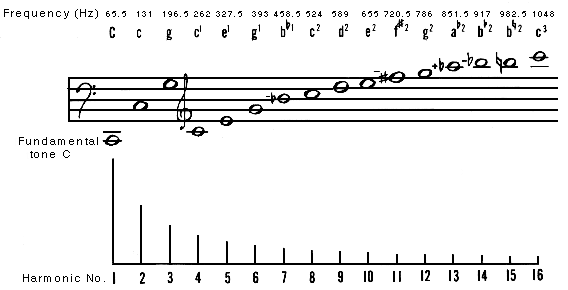|
|
In music, an adjective referring to HARMONY and its principles. In ACOUSTICS, when a vibrating object, such as a string, is set in motion, it vibrates both as a whole, with a FREQUENCY called the FUNDAMENTAL, and, with lesser intensity, in sections as well. If these smaller lengths are integer fractions (1/2, 1/3, 1/4, ...) of the total length of the string, their frequencies of OSCILLATION are called harmonics, and are integer multiples of the fundamental.
Other resonating frequencies which are not whole multiples of the fundamental may also be present, and are called PARTIALs. Bells, for instance, have many partials in their spectra, more than strings or pipes. It is the presence and relative strengths of harmonics and partials in a SPECTRUM that are largely responsible for the tone quality (TIMBRE) of any sound-producing body.
See also: FOURIER ANALYSIS, HELMHOLTZ RESONATOR, PHASE DIFFERENCE, RESIDUE, VOWEL. Compare: AURAL HARMONICS.
Note: In some texts, the term 'partial' refers to both harmonic and INHARMONIC resonating frequencies. In other words, all harmonics are then partials, but not all partials are harmonics. OVERTONE is often used to designate both harmonics and partials. However, it should be noted that while the fundamental is numbered as the first harmonic (as above), the first numbered overtone is the second harmonic (i.e. the OCTAVE above the fundamental). Compare: SUBHARMONIC.
The harmonics generated by a vibrating body may be represented in an ordered series called the HARMONIC SERIES. The combination of any subset of harmonics produces a harmonic spectrum (see LAW OF SUPERPOSITION). The first 16 harmonics of the series may be represented in musical notation and as a line SPECTRUM as follows:

The first 16 partials of the harmonic series in musical and acoustic notation. The plus and minus signs indicate that the 7th, 11th and 14th partials are lower than the notated pitch, and the 13th higher respectively. The other harmonics, other than the OCTAVEs, lie fairly close to the notes shown.
![]() Sound
Example: Harmonic series (up to the
16th harmonic) synthesized with sine waves at the frequencies
indicated above.
Sound
Example: Harmonic series (up to the
16th harmonic) synthesized with sine waves at the frequencies
indicated above.
Sound Example: Glissando through the harmonics of two cello strings.
home